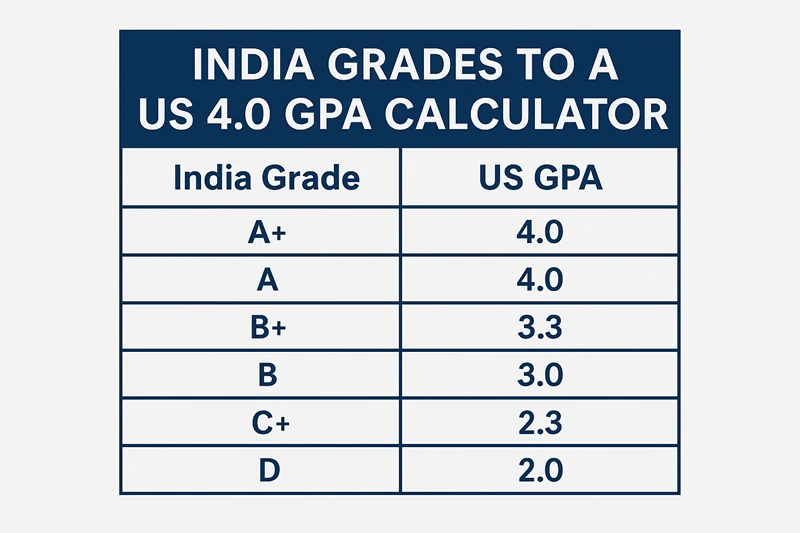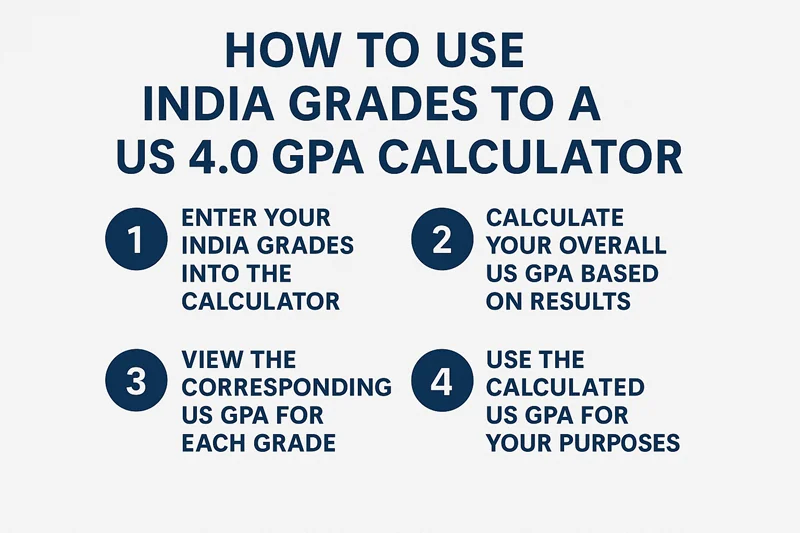Planning to study in the United States? Converting your Indian grades to the US 4.0 GPA scale is a crucial step in your application process. Whether you have a CGPA from an Indian university or percentage marks from your board exams, understanding how to accurately convert these to the American GPA system can significantly impact your admission chances.
This comprehensive guide provides you with everything you need: conversion formulas, detailed charts, practical examples, and answers to frequently asked questions about CGPA to GPA conversion India processes.
Convert Your Indian Grades to a 4.0 GPA Instantly
Converting your Indian academic performance to the US GPA scale doesn’t have to be complicated. With the right understanding of both grading systems and proper conversion methods, you can accurately translate your achievements for American universities.
Choose CGPA or Percentage
Before starting your conversion, identify which grading system your Indian institution uses:
CGPA (Cumulative Grade Point Average): Most Indian universities use a 10-point CGPA scale where 10.0 represents the highest achievement. This system is common in engineering colleges, central universities, and many state universities.
Percentage System: Traditional Indian boards and some universities still use percentage marking, where 100% is the maximum possible score. This system is prevalent in CBSE, ICSE, and various state board examinations.
Enter Your Grade and Get Instant Results
The conversion process varies depending on your input format:
- For CGPA: Use the standard formula (CGPA ÷ 10) × 4
- For Percentage: First convert to CGPA using (Percentage ÷ 9.5), then apply the GPA formula
- Direct Percentage to GPA: Use (Percentage ÷ 100) × 4 for a simplified approach
Remember that different universities and evaluation services may use slightly different conversion methods, so always verify with your target institution’s specific requirements.
How to Convert Indian Grades to US GPA (Step-by-Step Guide)
Converting Indian percentage to US 4.0 GPA requires understanding both educational systems and applying the correct mathematical formulas. This step-by-step process ensures accuracy in your conversions.
Understand Your Indian Grading Format
Indian educational institutions primarily use two grading formats:
10-Point CGPA System: Introduced to standardize academic evaluation across Indian universities. In this system, letter grades (A+, A, B+, B, C, D, F) correspond to grade points (10, 9, 8, 7, 6, 5, 0 respectively).
Percentage System: The traditional method where your total marks are calculated as a percentage of maximum possible marks. For example, scoring 850 out of 1000 marks equals 85%.
Learn the US 4.0 GPA Scale Basics
The American GPA system operates on a 4.0 scale where:
- A grade = 4.0 GPA (90-100%)
- B grade = 3.0 GPA (80-89%)
- C grade = 2.0 GPA (70-79%)
- D grade = 1.0 GPA (60-69%)
- F grade = 0.0 GPA (Below 60%)
This system emphasizes consistent performance across all subjects rather than just overall percentage achievement.
Use the Formula: (Your Score ÷ 10) × 4
The most widely accepted formula for 10-point CGPA to 4-point GPA conversion is:
GPA = (CGPA ÷ 10) × 4
This formula assumes that a 10.0 CGPA (perfect score in India) equals a 4.0 GPA (perfect score in the US). The linear conversion maintains proportional relationships between different grade levels.
Example Calculation: 8.5 CGPA → 3.4 GPA
Let’s work through a practical example:
Given: 8.5 CGPA on a 10-point scale Formula: (8.5 ÷ 10) × 4 Calculation: 0.85 × 4 = 3.4 Result: 3.4 GPA on a 4.0 scale
This 3.4 GPA represents a strong academic performance that would be competitive for many US universities, especially for graduate programs.
Indian vs. US Grading System Comparison
Understanding the fundamental differences between Indian grading system to GPA conversions requires comparing evaluation philosophies, grading curves, and academic expectations in both countries.
Indian CGPA/Percentage Overview
Indian universities typically follow strict grading standards where achieving above 85% or 8.5 CGPA is considered exceptional performance. The system often uses absolute grading rather than curve-based evaluation.
Key Characteristics:
- Emphasis on theoretical knowledge and comprehensive examinations
- Limited grade inflation compared to some Western systems
- Distinction typically awarded for 75%+ or 7.5+ CGPA
- First class requires 60%+ or 6.0+ CGPA
US GPA Scale Explained
American universities use a 4.0 GPA system that often incorporates grade curves, continuous assessment, and varied evaluation methods including projects, presentations, and participation grades.
System Features:
- Heavy weightage on assignments, quizzes, and class participation
- Grade curves that adjust student performance relative to peers
- Different GPA calculations (weighted vs. unweighted)
- Semester-based credit system affecting overall GPA
Key Differences in Evaluation Standards
The major difference lies in evaluation philosophy. Indian systems typically use high-stakes examinations, while US systems emphasize continuous assessment and holistic evaluation methods.
Grading Philosophy Differences:
- Indian system: Absolute grading with rigid marking schemes
- US system: Relative grading with flexible assessment methods
- Indian focus: End-semester examinations (70-80% weightage)
- US focus: Continuous evaluation throughout the semester


